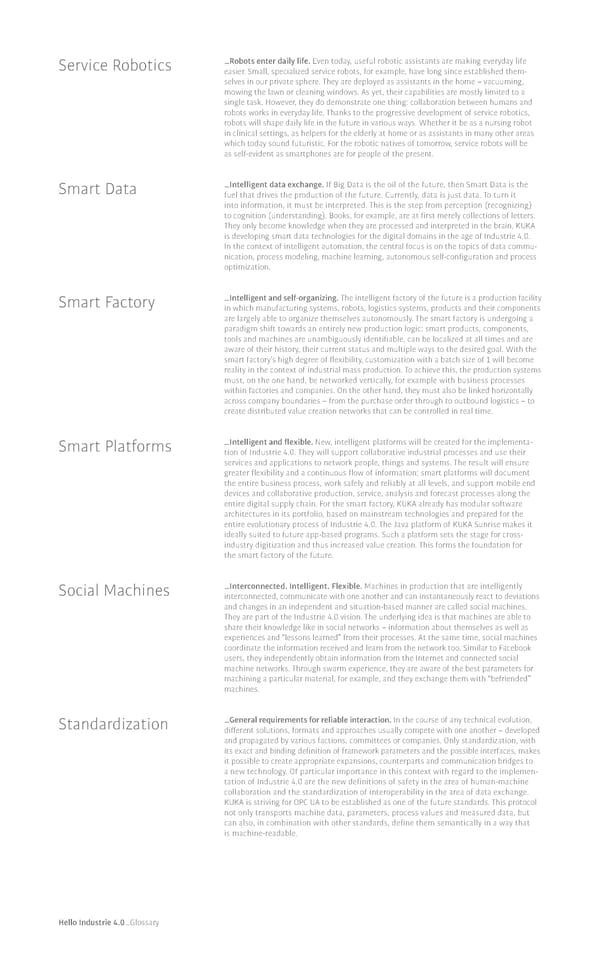Service Robotics �Robots enter daily life. Even today, useful robotic assistants are making everyday life easier. Small, specialized service robots, for example, have long since established them- selves in our private sphere. They are deployed as assistants in the home – vacuuming, mowing the lawn or cleaning windows. As yet, their capabilities are mostly limited to a single task. However, they do demonstrate one thing: collaboration between humans and robots works in everyday life. Thanks to the progressive development of service robotics, robots will shape daily life in the future in various ways. Whether it be as a nursing robot in clinical settings, as helpers for the elderly at home or as assistants in many other areas which today sound futuristic. For the robotic natives of tomorrow, service robots will be as self-evident as smartphones are for people of the present. Smart Data �Intelligent data exchange. If Big Data is the oil of the future, then Smart Data is the fuel that drives the production of the future. Currently, data is just data. To turn it into information, it must be interpreted. This is the step from perception (recognizing) to cognition (understanding). Books, for example, are at first merely collections of letters. They only become knowledge when they are processed and interpreted in the brain. KUKA is developing smart data technologies for the digital domains in the age of Industrie 4.0. In the context of intelligent automation, the central focus is on the topics of data commu- nication, process modeling, machine learning, autonomous self-configuration and process optimization. Smart Factory �Intelligent and self-organizing. The intelligent factory of the future is a production facility in which manufacturing systems, robots, logistics systems, products and their components are largely able to organize themselves autonomously. The smart factory is undergoing a paradigm shift towards an entirely new production logic: smart products, components, tools and machines are unambiguously identi昀椀able, can be localized at all times and are aware of their history, their current status and multiple ways to the desired goal. With the smart factory’s high degree of 昀氀exibility, customization with a batch size of 1 will become reality in the context of industrial mass production. To achieve this, the production systems must, on the one hand, be networked vertically, for example with business processes within factories and companies. On the other hand, they must also be linked horizontally across company boundaries – from the purchase order through to outbound logistics – to create distributed value creation networks that can be controlled in real time. Smart Platforms �Intelligent and flexible. New, intelligent platforms will be created for the implementa- tion of Industrie 4.0. They will support collaborative industrial processes and use their services and applications to network people, things and systems. The result will ensure greater flexibility and a continuous flow of information: smart platforms will document the entire business process, work safely and reliably at all levels, and support mobile end devices and collaborative production, service, analysis and forecast processes along the entire digital supply chain. For the smart factory, KUKA already has modular software architectures in its portfolio, based on mainstream technologies and prepared for the entire evolutionary process of Industrie 4.0. The Java platform of KUKA Sunrise makes it ideally suited to future app-based programs. Such a platform sets the stage for cross- industry digitization and thus increased value creation. This forms the foundation for the smart factory of the future. Social Machines �Interconnected. Intelligent. Flexible. Machines in production that are intelligently interconnected, communicate with one another and can instantaneously react to deviations and changes in an independent and situation-based manner are called social machines. They are part of the Industrie 4.0 vision. The underlying idea is that machines are able to share their knowledge like in social networks – information about themselves as well as experiences and “lessons learned” from their processes. At the same time, social machines coordinate the information received and learn from the network too. Similar to Facebook users, they independently obtain information from the Internet and connected social machine networks. Through swarm experience, they are aware of the best parameters for machining a particular material, for example, and they exchange them with “befriended” machines. Standardization �General requirements for reliable interaction. In the course of any technical evolution, di昀昀erent solutions, formats and approaches usually compete with one another – developed and propagated by various factions, committees or companies. Only standardization, with its exact and binding de昀椀nition of framework parameters and the possible interfaces, makes it possible to create appropriate expansions, counterparts and communication bridges to a new technology. Of particular importance in this context with regard to the implemen- tation of Industrie 4.0 are the new de昀椀nitions of safety in the area of human-machine collaboration and the standardization of interoperability in the area of data exchange. 阀阀 is striving for OPC UA to be established as one of the future standards. This protocol not only transports machine data, parameters, process values and measured data, but can also, in combination with other standards, de昀椀ne them semantically in a way that is machine-readable. Hello Industrie 4.0�Glossary
 Embracing Industrie Page 99 Page 101
Embracing Industrie Page 99 Page 101